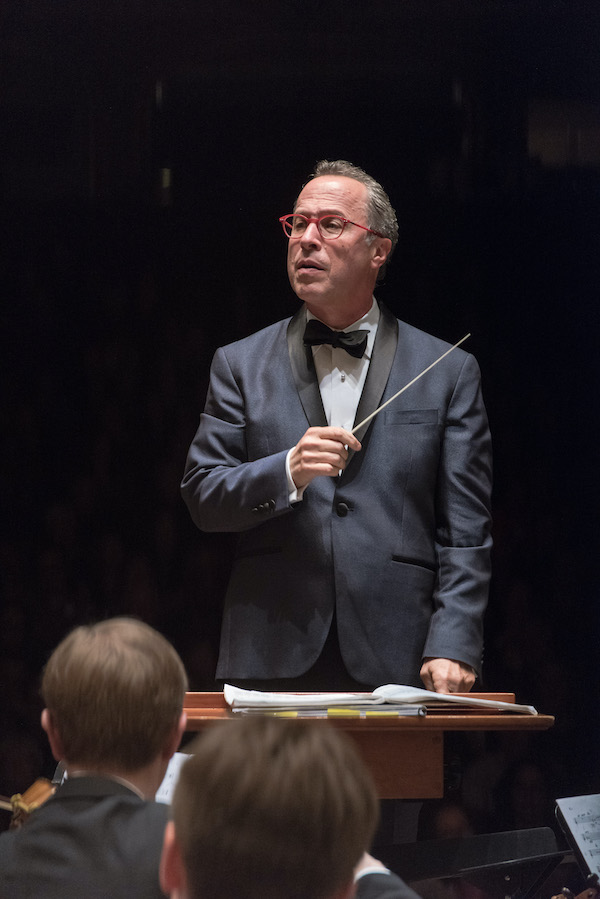Albany Symphony wraps season with an American celebration

The Albany Symphony Orchestra delivered their final season concert Saturday night at the Troy Savings Bank Hall (also live-streamed via the web) with a generous selection of contemporary American music. The “Trailblaze!” program featured the American premiere of John Williams’ Prelude and Scherzo and John Corigliano’s recent Triathlon for Saxophonist and Orchestra, alongside colorful orchestral works by Gabriella Smith and the late Steven Stucky.
There was a real sense of enthusiasm and concentration about the orchestra’s playing, with clear rhythms and details under David Allen Miller’s conducting. Miller gave brief introductions to each piece, which is always welcome, and the audience responded in turn with attention and generous applause.
The opening work was Smith’s Field Guide, the composer’s representation of, in Miller’s words, a “dawn chorus” of birds. The piece came across as both less and more than that—less in that the regular, treading rhythms were too orderly to evoke the charming chaos of simultaneous bird calls one hears at daybreak; and more, in the way the music added harmonies and dramatic shape to the depiction. The piece manufactures its own terraced propulsion, and the orchestra assembled this bit by bit. In their playing, Field Guide was a rousing passage from pre-dawn darkness to a scene fully lit by the brightness of the sun.
After dawn, came a prelude—literally—with John Williams’ Prelude and Scherzo, orchestral music with a concertante piano part played by Gloria Cheng. As Miller explained, this originally was slated for the Albany Symphony to premiere, but pandemic cancellations meant the piece was first played in Spain.
The Prelude had an intriguing antiphony between a psychologically and harmonically complex solo part, and Williams’ classic sound—rich orchestral harmonies with the shine and simple eloquence of mid-20th century American tonal modernism. Despite the expressiveness of her part, Cheng’s playing was unsentimental, which was an effective setup for the Scherzo. More than just playful, the music established an intense feeling, then proceeded to pick itself apart and reassemble. Rhythmically and structurally tricky, this was an impressive performance from the orchestra and Cheng, who seemed to relish the extreme angularity of much of the writing.
The second half began with Stucky’s Radical Light. Full of gorgeous colors, the piece—a sort of miniature concerto for orchestra—is ostensibly a response to Sibelius but just as much looks back to Debussy. Put the two together, and you’ve got both mystery and solidity, depth and playfulness. This is the kind of piece that displays what an orchestra can do, in this case play vibrantly, with bright, clear lines between instrumental groups and the sections of the work. As in some of Stucky’s compositions, though, the cascade of appealing details didn’t point to a central purpose, other than organized sounds. This is music that’s illuminating but not expressive.
The concert’s lively first-half momentum slowed considerably in the second half with the 15-minute Radical Light, then further with Corigliano’s spoken introduction to his saxophone concerto. But it did pick up again with the opening bars, soloist Timothy McAllister’s squealing announcement on soprano sax, followed by an energetic fanfare in the orchestra.
The three-part challenge for McAllister—a member of PRISM saxophone quartet—was switching from soprano to alto and then to baritone, then back, in the course of the piece. A tremendous saxophonist, McAllister played with great strength, bright tone, and excellent intonation—including the altissimo register—on all his horns. The orchestra sounded equally solid and confident.
The first section starts at a peak, descends into a calm valley, then hits a high point of discordant intensity before coming to a close. The second movement was slower and quieter, but with an undercurrent of lament, carried by slowly moving harmonies and McAllister’s beautiful alto sound. Corigliano’s superb orchestration used signal processing on the soloist, thickened by the woodwind section, with waves of limpid, consonant sound rippling out from the players and moving in every direction.
The instrumental range kept dropping, with McAllister picking up the baritone for the final movement, and the sound processing came to the fore, with tongue-slaps and key-clacks shimmering into brittle swarms of eerie sounds. These blended with powerful playing in the orchestra to make for a rugged, stressful opening. That intensity never let up.
The monochrome feel of the finale was in some ways a let down from the nuanced moods and expressions of the first two movements, but the overall energy was exciting, not just from McAllister but channeled through the orchestra, and in the end it bought the house down in cheers for soloist, orchestra, and composer.
The Albany Symphony’s “Trailblaze” programs will continue at various sites throughout the Albany region, June 5 through July 3. albanysymphony.com